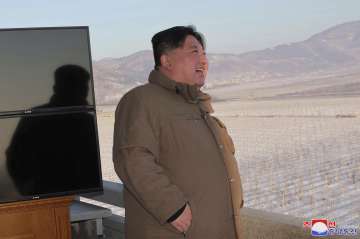North Korea: Kim threatens 'more offensive actions' against US after powerful missile test
Kim stressed the need to “never overlook all the reckless and irresponsible military threats of the enemies … and to strongly counter them with more offensive actions".

North Korean leader Kim Jong Un threatened “more offensive actions” to repel what he called increasing US-led military threats after he supervised the third test of his country's most advanced missile designed to strike the mainland US. Kim's statement suggests he is confident in his growing missile arsenal and will likely continue weapons testing activities ahead of next year's presidential election in the United States.
However many observers say North Korea still needs to perform more significant tests to prove it has functioning missiles targeting the US mainland. After watching Monday's launch of the Hwasong-18 intercontinental ballistic missile, Kim said the test showed how North Korea could respond if the United States were to make "a wrong decision against it,” according to the official Korean Central News Agency.
Kim stressed the need to “never overlook all the reckless and irresponsible military threats of the enemies … and to strongly counter them with more offensive actions,” KCNA said.
What is ICBM?
The Hwasong-18 ICBM is a developmental, solid-fueled ICBM that is considered North Korea's most powerful weapon. Its built-in solid propellant makes launches harder for outsiders to detect than liquid-fueled missiles, which must be fueled before liftoffs. However many foreign experts say North Korea still has some other technological hurdles to master to acquire reliable nuclear-tipped ICBMs, such as one to protect warheads from the harsh conditions of atmospheric reentry.
KCNA said the Hwasong-18 missile, launched on a high angle to avoid neighbouring countries, flew a distance of 1,002 kilometres for 73.5 minutes at a maximum altitude of 6,518 kilometres before landing in an area off the North's east coast. It said Kim expressed “great satisfaction” with the launch, which verified again the reliability of “the most powerful strategic core striking means” of North Korea.
It was the North's third test of the Hwasong-18 missile. Its two previous launches occurred in April and July. “Based on their statement, this looks to have been an exercise in signalling and a developmental test in one,” said Ankit Panda, an expert with the Carnegie Endowment for International Peace. “There's nothing new here technically as far as I can tell at this early stage, but they're certainly growing increasingly confident in their new solid propellant ICBM.”
North's latest ICBM test is yet another indicator Ttechnology progress
Leif-Eric Easley, a professor at Ewha University in Seoul, said the North's latest ICBM test is yet another indicator of how far its missile engine technology has progressed, but added there are limits to what North Korea can learn from lofted trajectory firings.
“Demonstrating warhead targeting and reentry capabilities would involve provocative launches across greater distances,” Easley said. “So more significant tests of both technology and diplomacy are likely in the New Year.”
KCNA said its Hwasong-18 test was meant to issue a warning over its rivals' confrontational military moves on North Korea. It said a recent U.S.-South Korean meeting to discuss their nuclear deterrence plan openly revealed their intention to hold joint drills with a simulated nuclear attack on North Korea.
It also referred to the second Nuclear Consultative Group meeting between senior U.S. and South Korean officials last Friday. During their meeting in Washington, the two countries agreed to update their nuclear deterrence and contingency strategies and incorporate nuclear operation scenarios in their combined military exercises next summer, according to officials in Seoul.
South Korean President Yoon Suk Yeol said during a Cabinet Council meeting on Tuesday that a “nuclear-based, powerful Korea-U.S. alliance” would be formed soon.
The consultative body is responsible for sharing information on nuclear and strategic weapons operation plans and joint operations, though the U.S. will retain operational control of its nuclear weapons. The group's establishment was part of U.S. efforts to ease South Korean worries about North Korean provocations while keeping Seoul from pursuing its own nuclear program.
North Korea back-to-back missile tests
Since last year, North Korea has performed more than 100 ballistic missile tests in violation of U.N. bans in what outside experts call an effort to upgrade its nuclear arsenal and win greater U.S. concessions. The North has still avoided fresh international sanctions as China and Russia blocked the U.S. and others' efforts to toughen U.N. sanctions on the country. North Korea also faces outside suspicions that it receives sophisticated weapons technologies from Russia in return for supplying conventional arms to support Russia's war in Ukraine.
The United States and South Korea have expanded their military training and increased the temporary deployments of powerful U.S. military assets in South Korea. On Tuesday, South Korea, the U.S. and Japan began putting into operation the sharing of real-time missile warning data on North Korea and established details of their trilateral exercises in coming years, South Korea's Defense Ministry said in a statement. It added the three countries will beef up their three-way cooperation to cope with regional challenges and promote peace in the region.
(With inputs from agency)